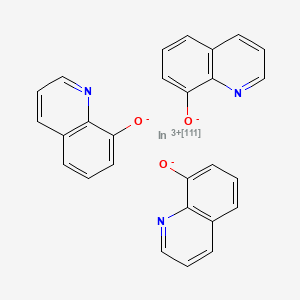



1. Indium In 111 Oxyquinoline
2. 65389-08-4
3. Indium-111(3+);quinolin-8-olate
4. Indium In-111 Oxine
5. Indium (111 In) Oxyquinoline
6. Indium-111 Oxine
7. Indium In111 Oxine
8. In-111 Oxyquinoline
9. Indium (in111) Oxine
10. Indium 111in Oxyquinoline
11. Indium (in111) Oxyquinoline
12. Indium Oxine In 111 (tn)
13. Indium-111 Oxyquinoline
14. Dtxsid70984005
15. Indium In 111 Oxyquinoline (usp)
16. Indium (111in) Oxyquinoline Solution
17. Db09473
18. D04526
| Molecular Weight | 543.4 g/mol |
|---|---|
| Molecular Formula | C27H18InN3O3 |
| Hydrogen Bond Donor Count | 0 |
| Hydrogen Bond Acceptor Count | 6 |
| Rotatable Bond Count | 0 |
| Exact Mass | 543.03992 g/mol |
| Monoisotopic Mass | 543.03992 g/mol |
| Topological Polar Surface Area | 108 Ų |
| Heavy Atom Count | 34 |
| Formal Charge | 0 |
| Complexity | 138 |
| Isotope Atom Count | 1 |
| Defined Atom Stereocenter Count | 0 |
| Undefined Atom Stereocenter Count | 0 |
| Defined Bond Stereocenter Count | 0 |
| Undefined Bond Stereocenter Count | 0 |
| Covalently Bonded Unit Count | 4 |
| 1 of 2 | |
|---|---|
| Drug Name | Indium in-111 oxyquinoline |
| Active Ingredient | Indium in-111 oxyquinoline |
| Dosage Form | Injectable |
| Route | Injection |
| Strength | 1mci/ml |
| Market Status | Prescription |
| Company | Ge Healthcare |
| 2 of 2 | |
|---|---|
| Drug Name | Indium in-111 oxyquinoline |
| Active Ingredient | Indium in-111 oxyquinoline |
| Dosage Form | Injectable |
| Route | Injection |
| Strength | 1mci/ml |
| Market Status | Prescription |
| Company | Ge Healthcare |
Indium In 111 oxyquinoline is indicated for radiolabeling autologous leukocytes.
FDA Label
Absorption
After injection of labeled leukocytes into normal volunteers, about 30% of the dose is taken up by spleen and 30% by liver, reaching a plateau at 2-48 hours after injection.
Route of Elimination
Elimination from the body of injected indium In 111 oxyquinoline is probably mainly through decay to stable cadmium since only a negligible amount (less than 1%) of the dose is excreted in feces and urine in 24 hours.
Clearance
Clearance from whole blood and biological distribution can vary considerably with the individual recipient, the condition of the injected cells and labeling techniques used. Clearance from liver and spleen, for the purpose of calculating the radiation dose, is assumed to be equal to the physical half-life of indium In 111 (67.2 hours).
Indium In 111 decays by electron capture with a physical half-life of 67.2 hours (2.8 days). Between 9.5 to 24.4% of the injected dose remains in whole blood and clears with a biological half-time of 2.8 to 5.5 hours. The remainder (13-18%) clears from blood with a biological half-time of 64 to 116 hours.
Indium-111 decays by isomeric transition and electron capture to cadmium-111, emitting a gamma ray that can be detected with a gamma ray camera. Following intravenous administration, the lipid-soluble complex is able to penetrate platelet cell membranes. Once inside, Indium detaches from the oxyquinoline complexes and becomes attached to cytoplasmic components.